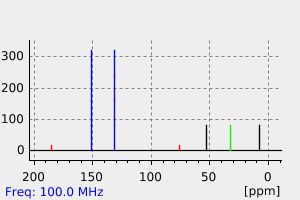4-ethyl-4-methoxycyclohexa-2,5-dien-1-one | 110391-94-1
中文名称
——
中文别名
——
英文名称
4-ethyl-4-methoxycyclohexa-2,5-dien-1-one
英文别名
4-ethyl-4-methoxycyclohexa-2,5-dienone;Ctxhsowqvzhgro-uhfffaoysa-
CAS
110391-94-1
化学式
C9H12O2
mdl
——
分子量
152.193
InChiKey
CTXHSOWQVZHGRO-UHFFFAOYSA-N
BEILSTEIN
——
EINECS
——
-
物化性质
-
计算性质
-
ADMET
-
安全信息
-
SDS
-
制备方法与用途
-
上下游信息
-
文献信息
-
表征谱图
-
同类化合物
-
相关功能分类
-
相关结构分类
计算性质
-
辛醇/水分配系数(LogP):1.2
-
重原子数:11
-
可旋转键数:2
-
环数:1.0
-
sp3杂化的碳原子比例:0.44
-
拓扑面积:26.3
-
氢给体数:0
-
氢受体数:2
反应信息
-
作为反应物:描述:4-ethyl-4-methoxycyclohexa-2,5-dien-1-one 在 rhenium(VII) oxide 作用下, 以 二氯甲烷 为溶剂, 反应 1.0h, 以93%的产率得到3-ethyl-4-methoxyphenol参考文献:名称:Re 2 O 7催化的二烯酮-苯酚重排†摘要:已经描述了由Re 2 O 7催化的4,4-二取代的环己二酮的二烯酮-苯酚重排。通过使用该催化方案,可以以良好或优异的收率有效地获得多取代的苯酚。DOI:10.1039/c5ra04931h
-
作为产物:描述:8-ethyl-8-methoxy-1,4-dioxaspiro[4.5]deca-6,9-diene 在 盐酸 作用下, 以91%的产率得到4-ethyl-4-methoxycyclohexa-2,5-dien-1-one参考文献:名称:2-(4-烷基苯氧基)乙醇衍生物的阳极氧化中的核与侧链反应性。2-羟乙基的有趣作用摘要:在恒定电流下使用氟化钾作为电解质,在甲醇中对2-(4-烷基苯氧基)乙醇衍生物进行阳极氧化,可以得到4-烷基-4-甲氧基环己-2,5-二烯酮缩醛的良好收率。DOI:10.1039/c39870000610
文献信息
-
Synthesis of Polysubstituted Bicyclo[3.3.1]nonane-3,7-diones from Cyclohexa-2,5-dienones and Dimethyl 1,3-Acetonedicarboxylate作者:Pelayo Camps、Albert González、Diego Muñoz-Torrero、Montserrat Simon、Adriana Zúñiga、Miriam A. Martins、Mercè Font-Bardia、Xavier SolansDOI:10.1016/s0040-4020(00)00680-3日期:2000.10Oxidation of polysubstituted phenols with phenyliodonium diacetate gives cyclohexa-2,5-dienones, which on reaction with dimethyl 1,3-acetonedicarboxylate afford double-Michael-addition derivatives, whose hydrolysis and decarboxylation provides polysubstituted bicyclo[3.3.1]nonane-3,7-diones. For steric and/or electronic reasons, the Michael reaction only works with 3,5-unsubstituted or 3-substituted
-
Iodobenzene and m-chloroperbenzoic acid mediated oxidative dearomatization of phenols作者:Neha Taneja、Rama Krishna PeddintiDOI:10.1016/j.tetlet.2016.07.078日期:2016.8iodobenzene, and m-CPBA as a co-oxidant has been achieved via in situ generation of PhIO2, a hypervalent iodine(V) species. The transiently generated orthobenzoquinone monoketals further underwent Diels–Alder reaction with various dienophiles to furnish densely substituted bicyclo[2.2.2]octenones in high selectivities and yields. This methodology features ready availability of reagents, cost effectiveness, safety
-
Zinc-catalyzed regioselective C–P coupling of <i>p</i>-quinol ethers with secondary phosphine oxides to afford 2-phosphinylphenols作者:Ming Zhang、Xiaoyu Jia、Haowei Zhu、Xutong Fang、Chenyi Ji、Sizhuo Zhao、Li-Biao Han、Ruwei ShenDOI:10.1039/c9ob00129h日期:——regioselective C–P cross coupling reaction of p-quinol ethers with secondary phosphine oxides is reported. The reaction provides a facile alternative method for the synthesis of 2-phosphinylphenols in good to high yields. Mechanistically, zinc triflate may serve as an oxophilic σ-Lewis acid to activate the C–O bond in p-quinol ether first. Then the regioselective attack of the phosphorus nucleophile at the α-carbon
-
Site-selective 1,3-double functionalization of arenes using <i>para</i>-quinol, C–N, and C–C/C–P three-component coupling作者:Saddam Husen、Anil Chauhan、Ravindra KumarDOI:10.1039/c9gc04103f日期:——
A catalytic and site-selective approach has been demonstrated for dual functionalization of arenes
via cross-coupling reactions ofp -quinols with amines and isocyanides/phosphites. -
A Variation of the Fischer Indolization Involving Condensation of Quinone Monoketals and Aliphatic Hydrazines作者:Jinzhu Zhang、Zhiwei Yin、Patrick Leonard、Jing Wu、Kate Sioson、Che Liu、Robert Lapo、Shengping ZhengDOI:10.1002/anie.201207533日期:2013.2.4new twist: A one‐pot nitrous acid free, diazonium‐free, and transition‐metal‐free variation of the Fischer indole synthesis has been developed. Condensation of quinone monoketals and aliphatic hydrazine hydrochlorides afforded indoles via intermediate alkylaryldiazenes. This method will complement the classical Fischer indole synthesis by providing indoles in two steps from widely available phenols
表征谱图
-
氢谱1HNMR
-
质谱MS
-
碳谱13CNMR
-
红外IR
-
拉曼Raman
-
峰位数据
-
峰位匹配
-
表征信息
同类化合物
(反式)-4-壬烯醛
(s)-2,3-二羟基丙酸甲酯
([1-(甲氧基甲基)-1H-1,2,4-三唑-5-基](苯基)甲酮)
(Z)-4-辛烯醛
(S)-氨基甲酸酯β-D-O-葡糖醛酸
(S)-3-(((2,2-二氟-1-羟基-7-(甲基磺酰基)-2,3-二氢-1H-茚满-4-基)氧基)-5-氟苄腈
(R)-氨基甲酸酯β-D-O-葡糖醛酸
(5,5-二甲基-2-(哌啶-2-基)环己烷-1,3-二酮)
(2,5-二氟苯基)-4-哌啶基-甲酮
龙胆苦苷
龙胆二糖甲乙酮氰醇(P)
龙胆二糖丙酮氰醇(P)
龙胆三糖
龙涎酮
齐罗硅酮
齐留通beta-D-葡糖苷酸
鼠李糖
黑芥子苷单钾盐
黑海棉酸钠盐
黑木金合欢素
黑曲霉三糖
黑介子苷
黄尿酸8-O-葡糖苷
麻西那霉素II
麦迪霉素
麦芽糖脎
麦芽糖基海藻糖
麦芽糖1-磷酸酯
麦芽糖
麦芽四糖醇
麦芽四糖
麦芽十糖
麦芽六糖
麦芽五糖水合物
麦芽五糖
麦芽五糖
麦芽五糖
麦芽三糖醇
麦芽三糖
麦芽三糖
麦芽三塘水合
麦芽七糖水合物
麦芽七糖
麦法朵
麦可酚酸-酰基-Β-D-葡糖苷酸
麦利查咪
麝香酮
鹤草酚
鸢尾酚酮 3-C-beta-D-吡喃葡萄糖苷
鸡矢藤苷







